#Kung Wo pawnshop
Photo
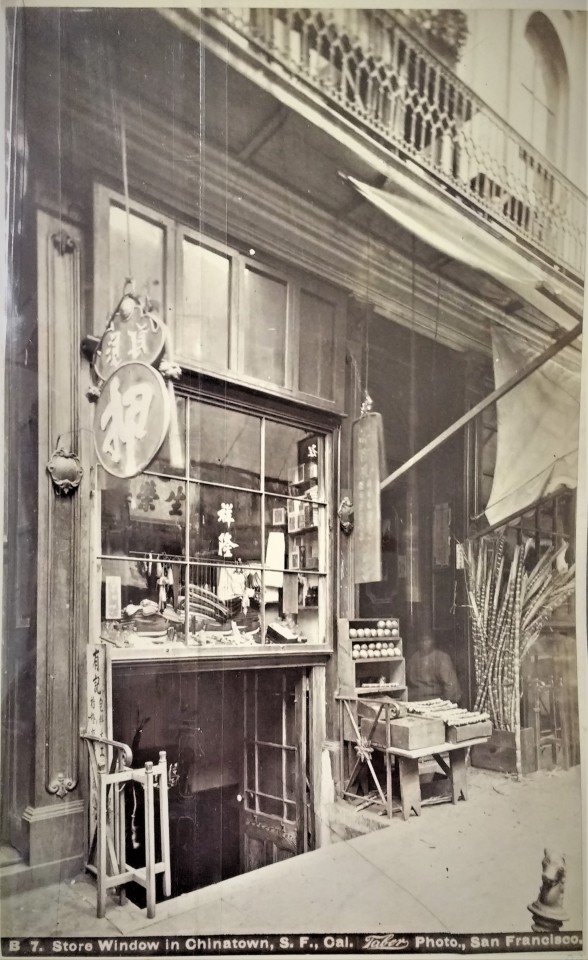
“B 7. Store Window in Chinatown, S.F., Cal.” c. 1885. Photograph by Isaiah West Taber (from the Cooper Chow collection at the Chinese Historical Society of America). The “B” designation referred to Taber Photo’s “Boudoir Photos” sold in the 5 x 8 size
The characters 祥隆 (canto: “Cheung Lung”), literally “auspicious prosperity” appear in the center pane of the storefront window. A second sign is visible inside the store, inscribed with the characters “榮生,” which, when read from right to left would be “生榮” (canto: “Saang Wing”). In the lower left-hand corner of the photo, the vertical signage for a business located in the basement appears below the lower left corner of the window display area. The name 有記 (canto: “Yow Gay”) appears, followed by what appear to the characters 包料木工枱瞪 (canto: “bau liu muk gung toy duhng;” lit. “packing woodworking table”), indicating the business of a woodworker or carpenter. The ghostly figure of a vendor can be seen in the entryway at right, presumably overseeing the small sidewalk display to the left of the store entrance. His relationship to the operators of the interior store space is not apparent. The left-center portion of I.W. Taber’s photo of a “Store Window in Chinatown” shows the prominent 押 character on the signage for a pawnshop. Typical for that era, the two-part signage of the bat hanging upside down and holding a coin is suspended from underneath the overhang of the first story’s balcony.
Pawnshops of Old Chinatown
When the Chinese pioneers began to settle in America, the appearance of pawnshops and pawnbrokers in cities and Chinatowns throughout the Pacific Coast and the western United States, became inevitable. Pawnshops, offering loans to borrowers and secured by personal property collateral, had traced their history more than three millennia to ancient China.
For lower income groups, pawnshops have, in the words of professor Heiko Schrader, “a high outreach, are very often financially viable and have several advantages, compared to other institutions of the micro financial sector. Clients cannot fall into long-term indebtedness, due to the fact that they have to deposit a pawn of at least the same value. And for the pawnshop this pawn reduces the risk to provide a loan to poor people, and monitoring is not necessary.”
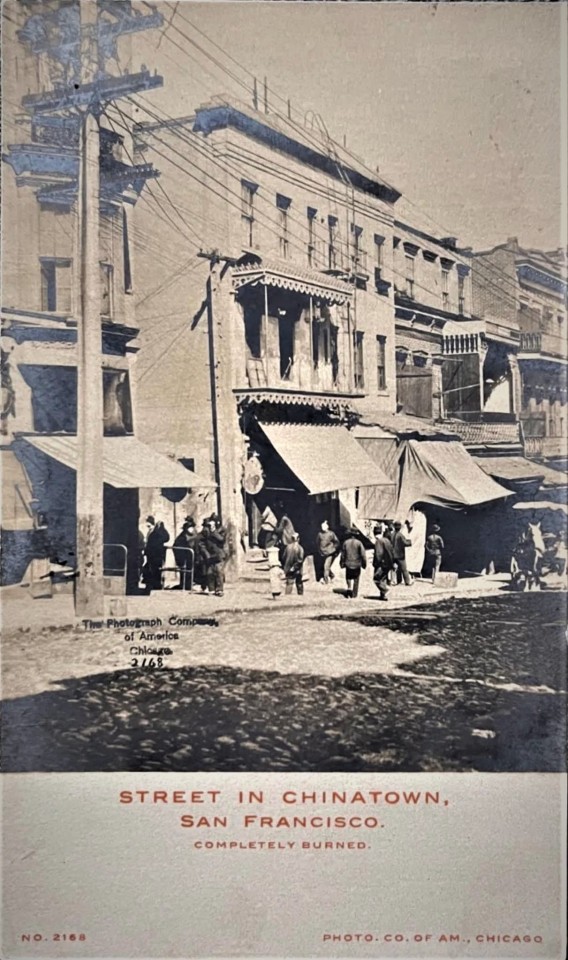
“Street in Chinatown, San Francisco. Completely Burned. No. 2168,” published c. 1906. Photographer unknown for the Photo. Co. of America, Chicago. The street is the pre-1906 pawnshop row along the north side of Washington Street at the southern entrance to Ross Alley. The pawnshop signage for the On Wing (安榮) store at 828 Washington appears in the center of the photo.
The photographic record of old San Francisco Chinatown’s streetscape provides numerous scenes of the southern Chinese pawn shop sign – the 押 character or symbol (canto: “aap”), literally a “mortgage” or pledge. Additional signage showing a bat holding a coin 蝠鼠吊金錢 (lit. “bat mouse hanging money;” canto: “fūk syú diu gām chin”), signifying fortune and the benefits denoted by the coin, can be discerned.

“The Sign of the Pawn Shop” c. 1896-1906. Photograph by Arnold Genthe (from the Genthe photograph collection, Library of Congress, Prints and Photographs Division). A print of a similar image appears in Old Chinatown : a book of pictures by Arnold Genthe with text by Will Irwin (New York : M. Kennerley, 1913, p. 195). The signage for the pawnbroker, Hang Lee & Co. (亨利押; canto: “Hung Lei aap;” pinyin: “Heng Li”) or “Pervasive Profit” pawnshop was located at 830 Washington Street near the entrance to Ross Alley, can be seen suspended in the foreground of the image. The Hang Lee pawnshop was located at 830 Washington Street, on the northwest corner of Washington Street and Stouts (or Ross) Alley – strategically situated within easy walking distance of gambling establishments and bordellos.
Historian Jack Tchen wrote in reference to Arnold Genthe’s photo “The Sign of the Pawnshop” for the Hang Lee & Co. as follows:
“Amid the gambling rooms where savings were quickly lost, pawnshops thrived. Pawnshops had very high counters upon which the item to be pawned would be place for inspection by an unseen shop worker, hidden behind the counter for security purposes. Often a man visiting his favorite prostitute or singsong girl would stop by the shop and pick up a present. [Arnold] Genthe developed his collection of jades by frequenting these stores. “
The residents of old Chinatown preferred to hold liquid assets in the form of gold or gems because of the relative ease with which they could arrange loans from pawnshops when they needed cash urgently. The neighborhood’s pawnbrokers located their shops in strategic proximity to houses of gambling and/or prostitution, with particular concentrations of shops on Washington and Jackson Streets.
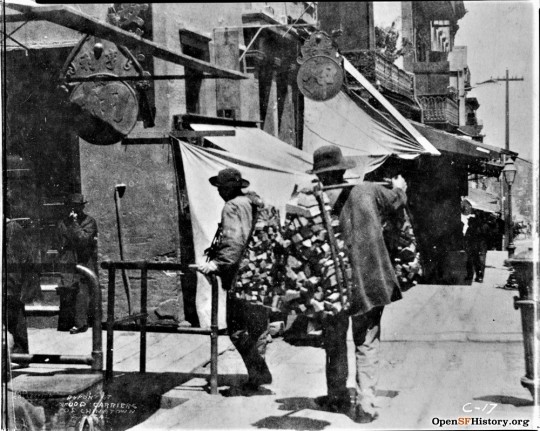
“Dupont St. Wood Carriers of Chinatown Sf Cal.” c. 1890. Photograph by A.J. McDonald (from the Marilyn Blaisdell collection). The wood carriers might have been based on Dupont Street, but the signage in the upper left-hand corner of the frame advertise the location of the Hang Lee & Co. pawnshop or “Pervasive Profit” pawnshop (亨利押; canto: “hung lei aap”), at 830 Washington Street, at the northwest corner of Washington Street and Stouts (or Ross) Alley. Also, the barely discernible signage for the On Wing (安榮) pawnshop slightly down the eastern incline of the street at 828 Washington can be seen in the upper center of the photo.
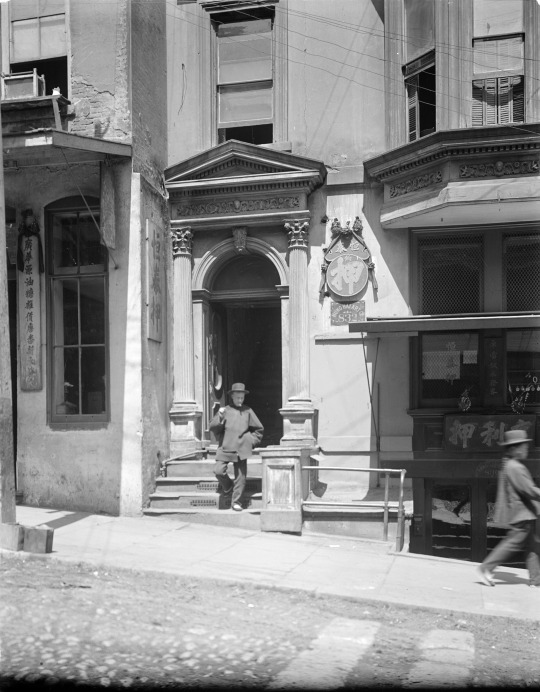
"Hung Ai[sic] Art Co. doorway, August 24, 1901.” Photograph by D. H. Wulzen (from the D.H. Wulzen Glass Plate Negative Collection (Sfp 40), San Francisco History Center, San Francisco Public Library).
In contrast to the misfortune which befell his contemporaries, the glass negatives of photographer D.H. Wulzen survived the quake and fire of 1906. As a result, the San Francisco Public Library provides higher quality images of Wulzen’s work online, such as his 1901 photo of the Hung Hai Art Co. at 832 Washington Street. Its name (恒泰) and address appear clearly in the center of the photo, as well as a prominent 押 (canto: “hung tai aap”) character emblazoned on an oversized coin topped by the usual inverted bat icon which holds the coin.
Additional confirmation of the address location on Washington Street may be found by the partially-obscured signage of its adjacent pawnshop, the Hang Lee & Co. (亨利押; canto: “hung lei aap”). The Hang Lee shop was located below street-level at 830 on the northwest corner of Washington Street and Stouts (or Ross) Alley.
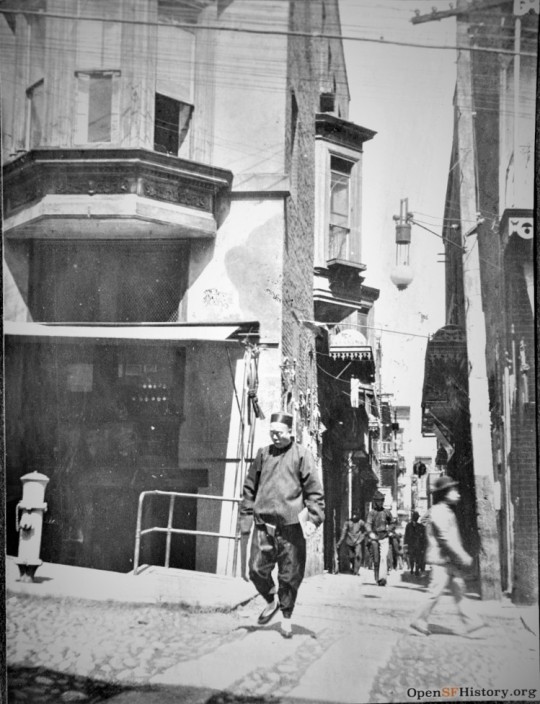
The below-street grade location of the Hang Lee & Co. pawnshop at 830 Washington Street on the northwest corner of the intersection of Washington Street and Ross Alley, c. 1900. Photograph by Henry H. Dobbin (from the Marilyn Blaisdell collection).
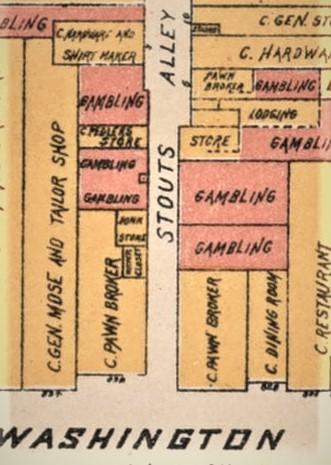
Detail of the locations of Chinese pawnbrokers’ shops on the north side of Washington Street as depicted on the San Francisco Board of Supervisors’ special committee map of July 1885 (from the Cooper Chow collection at the Chinese Historical Society of America). The address numbers of 828 (at the northeast corner of the inverse “T”-intersection and 830 (which was located below street level were omitted by the 1885 survey.

“136. Pawnbroker’s Shop, Chinatown, San Francisco, Cal.” no date. Photographer unknown, stereograph published by The Thomas Mfg. Co., Dayton, Ohio (from the private collection of Wong Yuen-ming).
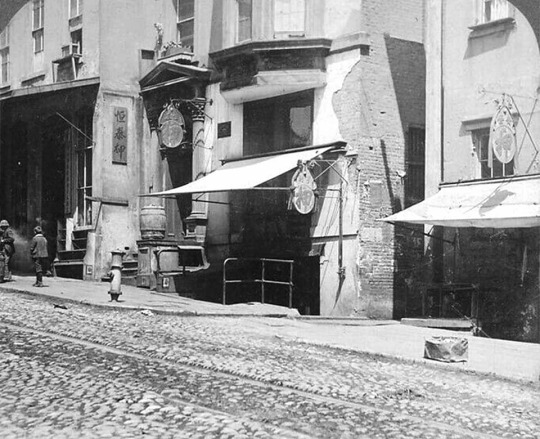
A single print (from a private collection) of the north side of Washington Street at the entrance to Ross Alley, flanked on the left by the Hung Hai Art Co. at no. 832, Hang Lee & Co. at no. 830, and, to the right of the entrance, the On Wing shop at 828 Washington Street. The trio of businesses represented a strategic and convenient cluster of pawnshops which San Francisco’s 1885 “vice map” recorded as occupying the north-side frontage of Washington extending west from Dupont Street and across Stouts (a.k.a. Ross) Alley.

The Horn Hong Company’s business calendar-directory of 1892 shows the pawnshops located in the 800-block of Washington Street, flanking the southern entrance to Ross Alley’s gambling establishments..
The 1885 map and the various business directories for Chinatown of the 1890’s show the pawnbrokers (including the Hung Hai company’s predecessor, Fong Chong Fook Kee & Co, which had occupied the 832 Washington premises during the 1880s and early ‘90s), had strategically situated themselves adjacent to, and within easy walking distance of, the gambling establishments and bordellos on Ross Alley.
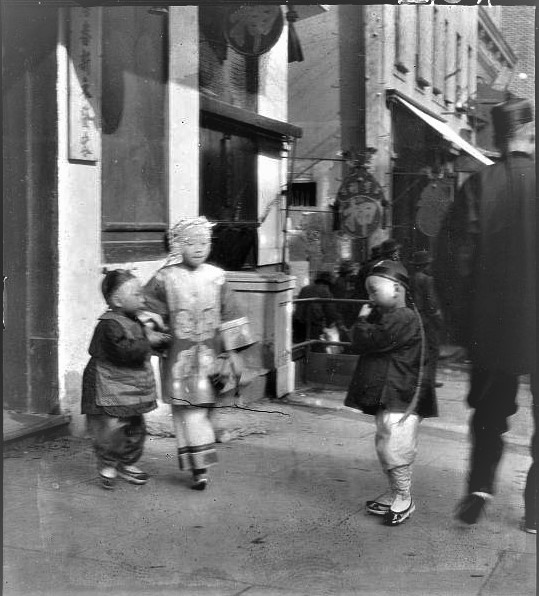
Three Children outside of the Hung Hai Art Co. pawnshop at 832 Washington Street and Ross Alley. The signage for the pawnbroker, Hang Lee & Co. (亨利押; canto: “Hung Lei aap;” pinyin: “Heng Li”) or “Pervasive Profit” pawnshop at 830 Washington Street is visible above the head of the boy in the right half of the frame. Photograph by Arnold Genthe, c. 1896 – 1906 (from the collection of the Library of Congress).

“Ross Alley Chinatown 1904.” Photograph by Henry H. Dobbin (from the collection of the California State Library). At right, the sign for the 巨興 (canto: “Geuih Hing”) or “Great Prosperity” pawnshop can be seen.
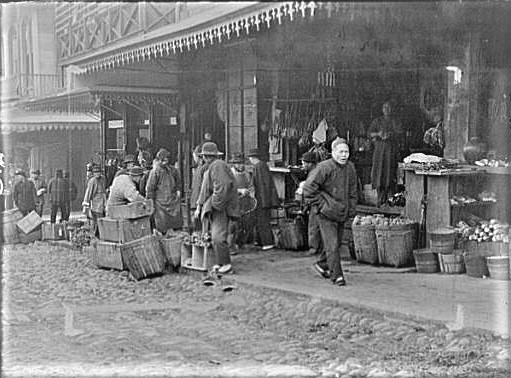
“The Morning Market” c. 1896-1906. Photograph by Arnold Genthe (from the Genthe photograph collection, Library of Congress, Prints and Photographs Division).
In the center of Arnold Genthe’s “Morning Market” photo of a Jackson Street block dominated by grocery stores, the glass windows of the Kung Wo pawnshop (公和押; pinyin: “Gunghe;” canto: “Gung Wo aap;” lit. “Honorable Peace Mortgage”) can be seen in the center of the photo at 639 Jackson Street, between the grocers Tuck Wo (德和) at 635 Jackson and Yee Chong (裕昌) at 639 Jackson.
The Chinese preferred to buy assets like gold or gems because of the relative ease with which they could arrange loans from pawnshops when they needed cash urgently. To respond to the cash demands by the dominant population of single male workers for the recreational services provided by sex workers and gambling operations, pawnshops proliferated in old Chinatown.

Detail from San Francisco’s 1885 vice map of the location of the predecessor pawnbrokerage to the Kung Wo pawnshop (公和押; pinyin: “Gunghe;” canto: “Gung Wo aap;” lit. “Honorable Peace Mortgage”) which would occupy 639 Jackson Street at the time of Arnold Genthe’s photo of the block, “The Morning Market.” The pawnshop was located at the top of the T-intersection of Jackson Street and the southern end of Bartlett Alley. The alley contained the highest concentration of Chinese houses of prostitution as depicted by the “C.P.” coding in the San Francisco Board of Supervisors’ special committee map of July 1885 (from the Cooper Chow collection at the Chinese Historical Society of America).
According historian Jack Tchen notes, “[Chinatown’s] pawnbrokers were primarily located on Jackson and Washington Streets, near the concentration of gambling rooms,” and the city’s 1885 “vice map” shows such location, as well as near houses of prostitution.

��Ross Alley, Chinatown” 1886. Oil painting by Edwin Deakin. The painting depicts a Chinese New Year’s celebration at the southern end of Ross Alley as viewed from Washington Street and the pawnshops flanking the entrance to the alleyway.
Having operated for more than three decades, Chinatown’s pawnshops were all destroyed during the Great Earthquake and Fire of 1906. However, the pawnbrokers reestablished their shops in the rebuilt neighborhood and often on familiar streets.

This post-1906 photo shows the T.G. Kong Co. pawnshop at the renumbered street address of 852 Washington Street, on the same northwest corner of Washington Street and Ross Alley.
The reminiscences of longtime Chinatown resident, Lyle Jan, about the new Chinatown’s pawnshops provide insights into how business was conducted during the era between the world wars:
“There were several pawn shops in Chinatown. I remember one in particular. It was located on the corner of Waverly Place next to Washington Street. I remember this particular pawnshop because my mother often visited this shop whenever we were short of cash.
“The pawn broker, or as he was also called, the moneylender, would provide money with interest, on personal property deposited with him as security. The pawnbroker kept the personal property until the borrower paid off his loan. Chinese gold jewelry is a personal property that can be easily pawned. The moneylender knew that if the borrower did not redeem the item, the gold jewelry would be fairly easy to sell to customers who seek a bargain on gold jewelry. The unredeemed gold jewelry is also attractive to goldsmiths who can melt the gold and make new jewelry from it.
“As a bit of added interest, during the 1930s and even up to the 40s, the street windows of pawn shops in Chinatown were boarded up so that passerbys on the street could not see the person inside the shop making a transaction. Inside the shop, the borrower faced an approximate 6 foot high counter with a wrought iron framework on the top. There was an opening in the framework much like the one for a teller in a bank. The borrower would hand the item he wanted to pawn with a raised arm and give it to the moneylender seated behind the opening of the wrought iron framework. The moneylender appraises the item to be pledged as security for the loan, then quotes the loan amount plus interest available to the borrower. If the borrower agrees to the loan terms, the money and a receipt is handed down to the borrower by the money lender. At no time was there a direct face to face contact between the moneylender and the borrower. . . .

“Customer at pawnbroker's shop remains hidden, slips camera through window for the Chinese consider it a disgrace to pawn anything”, 1944. Photograph by James Wong Howe on assignment for LOOK magazine (from the collection of the Bancroft Library).
“The reason for the boarded street windows and the high counter between the moneylender and borrower was an effort to provide privacy for the borrower during the loan transaction. It was considered a loss of face for anyone to go to a pawnshop to borrow money. This privacy bit was rather comical, in that probably more than half of the Chinatown residents have had to walk into the portals of a pawn shop for cash to tie them over temporarily, especially during the Depression Years in America. I wouldn't be surprised that when a borrower walked out the doors of a pawnshop after receiving a loan, his best friend or relative might be just walking in to pawn his or her personal property.
“There was another purpose for the high counter besides privacy. In case there was an attempted robbery, the height of the high counter would act as a physical obstacle to the robber.”
-- from China 2227 Long, Long Ago: Memoirs of Old San Francisco by Lyle Jan (Infinity Publishing.com, 2005)
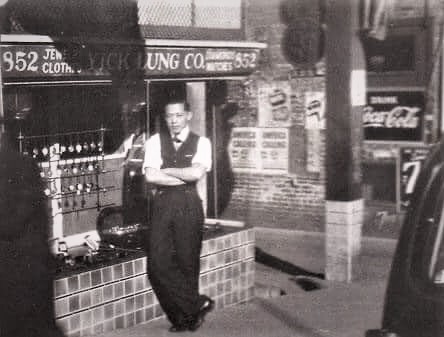
The Yick Lung Co. pawnshop operated at 852 Washington Street on the same northwest corner of Washington Street and Ross Alley as had its pre-1906 predecessor pawnbrokers. The proprietor’s name was Alexander Dea. Photographer unknown.
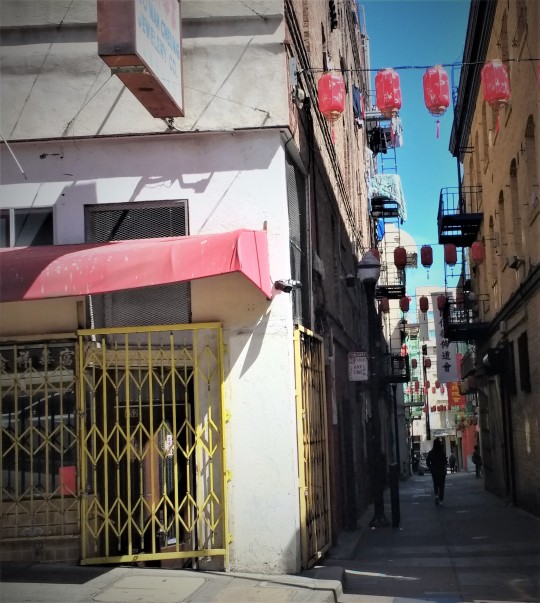
The sign of the Foo Wah Cheung hangs over the premises of 852 Washington Street at Ross Alley on June 8, 2022. Photograph by Doug Chan
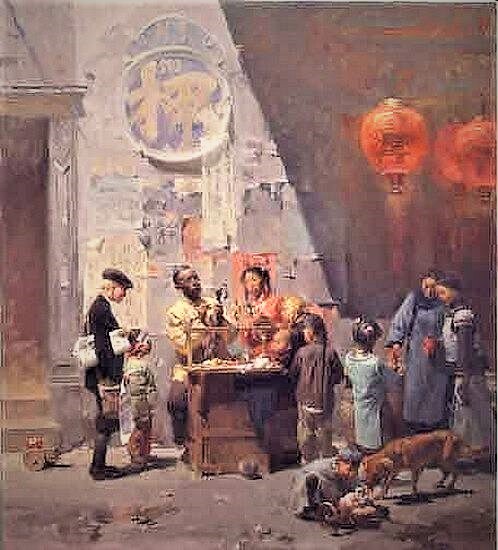
“Toymaker Off Ross Alley” Oil painting by Mian Situ. This historically-inspired painting by Situ depicts a street artist working under the faded signage of a pawnshop in front of a building façade (blending elements from the Hung Hai Art Co.’s Washington Street store frontage and the Ross Alley streetscape) from pre-1906 Chinatown. Although purporting to depict old Chinatown, the artist’s juxtaposing children with a deteriorating pawnbroker’s sign foreshadows the decline of a business sector which had served the old bachelor society and the concurrent rise of fully-formed families in the community.
With the dramatic growth of the Chinese population and families in Chinatown, the neighborhood’s once-ubiquitous pawnshops no longer play as prominent a role in the micro-economy of the once-segregated community. The pawnbrokers have faded from view, their functions assumed in large part by institutional lenders and the jewelry stores. They remain, however, an integral part of the colorful and historical past of San Francisco Chinatown’s.
youtube
“Arrest in Chinatown, San Francisco, Cal.” (c) October 25, 1897 by Thomas A. Edison, Inc., from the collection of the Library of Congress. “This film shows the arrest and conveyance of a Chinese man in Chinatown, watched by a crowd of onlookers. The precise date of this film and the arrest charge are uncertain. It is possible that the arrest was connected with the smuggling of illegal immigrants from China. By mutual agreement between China and the United States, a small quota of merchants and students was allowed to immigrate yearly, but few legal immigrants actually were of these professions, and illegal immigration continued. One of the San Francisco residences for new arrivals was located at 830/832 Washington Street, the general location from which the arrest[ed] party ascends at the start of the film. . ..” The signs of the pawnshops can be seen in the background.
#Pawnshops of San Francisco Chinatown#Chinatown pawnbrokers#Sign of the Pawnshop#Arnold Genthe#I.W. Taber#Hang Lee & Co.#Hung Hai Art Co.#On Wing#Horn Hong Company#Kung Wo pawnshop#Washington St.#Jackson St.#Ross Alley#Bartlett Alley#James Wong Howe#Mian Situ
2 notes
·
View notes